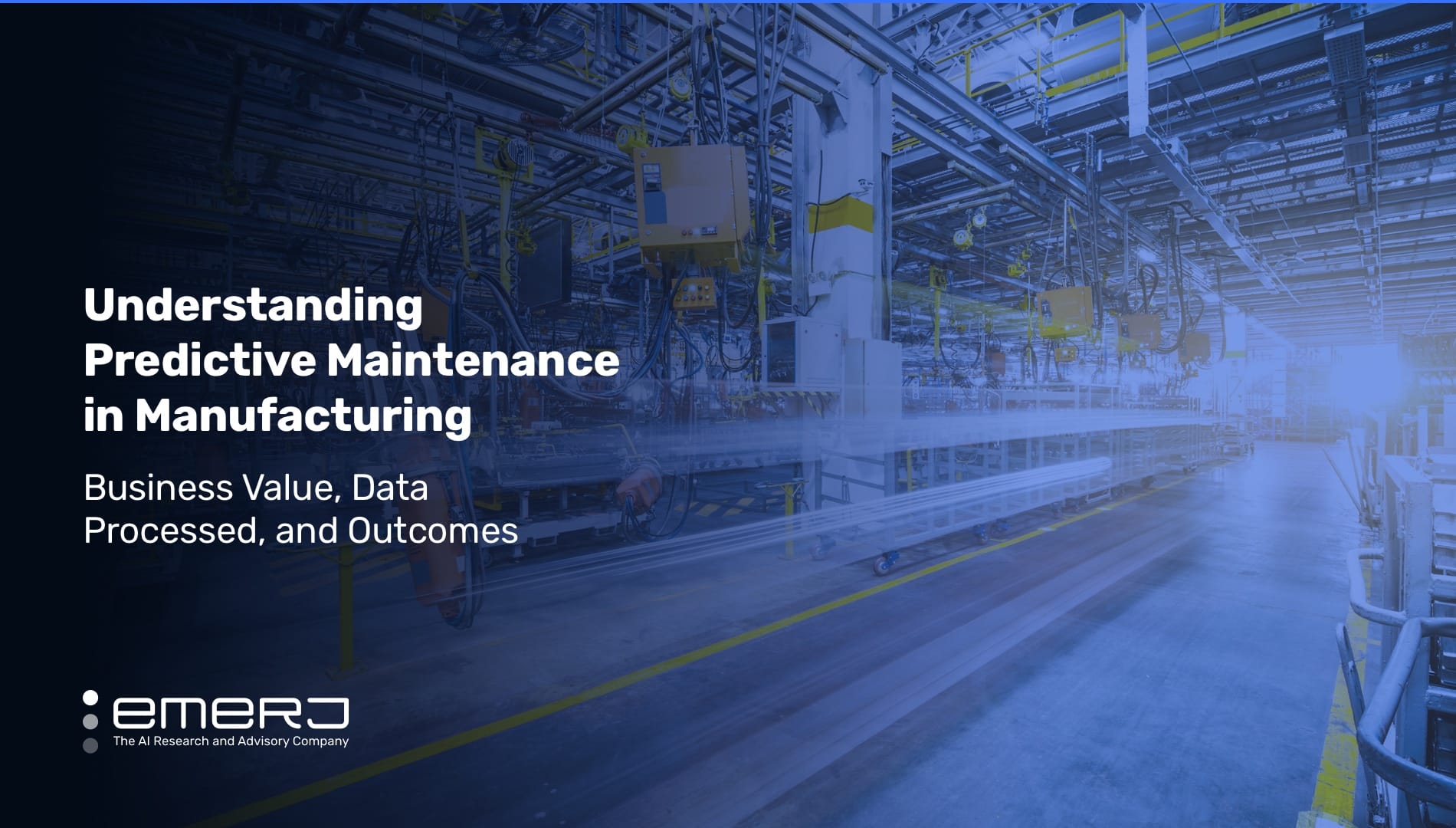The hypothesis is simple:
- Equipment breakdowns or downtime is extremely expensive (imagine a train broken down on isolated tracks, hundreds of miles from the nearest depot)
- Heavy equipment (engines, wind turbines, manufacturing machines) produce various streams of data (heat, vibration, time-series, etc)
- Machine learning could be used to detect “failure patterns” in that data, helping businesses to maintain equipment health more effectively
Putting this idea into practice is anything but simple.
Even two of the same pieces of equipment (i.e. two of the same model of drill in a manufacturing operation) can have unique patterns of data – and thus require unique calibration and diagnosis. Sensors to detect heat may not work well in colder seasons, or may fall off or lose their sensitivity when exposed to extreme conditions. Determining precisely what data should be used as the diagnostic data stream for a specific piece of equipment is also not easy, and may require expensive and time-consuming iteration. Even the most well-funded firms in industrial AI are still pivoting in order to find the right applications for machine learning in order to deliver consistent results for clients.
Despite these challenges, our AI Opportunity Landscape shows predictive maintenance to be one of the most funded use-cases of AI across all sectors of heavy industry, from utilities to transportation to manufacturing and beyond. The cost savings created by reducing downtime and failures is monumental (imagine what it costs to shut down the manufacturing line at a gigantic Toyota plant, or what it costs to shut down an oil rig in the middle of the ocean), and machine learning is suited for the complex pattern recognition required for this job – even if finding the right applications of sensors and algorithms is anything but easy.
In this article, we’ll explore the use-cases of predictive maintenance in manufacturing specifically, highlighting the business value of the process, the data and data processing involved, and the business outcomes and changes to workflows.
Business Value
Upkeep on physical equipment is expensive and time-consuming. In addition to the cost of human diagnostic efforts by trained professionals, equipment downtime can have downstream productivity impacts.
When a piece of manufacturing equipment (such as a drill or a lathe) is shut down for maintenance, the in-process inventory being fed to that machine must halt or be routed elsewhere. Backed up in-process inventory can create unpredictable downstream effects for other equipment, for transportation, and for the labor forces operating them – not to mention a potential failure to meet customer delivery expectations and deadlines.
Because the expense and impact of a breakdown or malfunction of equipment is so significant, manufacturing firms business must have consistent regiments of maintenance and upkeep in order to limit productivity disruption while also keeping a close pulse on the functioning of it’s most important equipment.
The potential for artificial intelligence to reduce downtime while also improving overall maintenance and monitoring of equipment is significant. Reducing risk and improving throughput (revenue) are important to any manufacturing operation.
Related Articles:
- AI for Predictive Maintenance Applications in Industry – Examining 5 Use Cases
- Predictive Maintenance in Oil and Gas – Vendors and Use-Cases
Data Involved
Predictive maintenance applications leverage a variety of data types:
- Sensor data on the equipment itself, including: Heat sensors, vibration sensors, movement sensors, and more.
- Programmable Logic Controller (PLC) data, including: Inputs entered into the machine, outputs from the machine, human instructions for the machine over time, and other factors.
- Computer vision. For example: A camera that watches how many times a press moves up or down, or which checks for the quality of a product on an assembly line.
- Time series data of known breakdowns, issues, or malfunctions – which can be tied back to sensor data in order to determine the state of the machine leading up to the issue.
- Relevant external data sources – This could involve data from other related equipment on a production line, or even weather data (if the weather or outside temperature might impact machine performance).
Different pieces of equipment will require a different mix of sensors, and it often requires experimentation to determine which data combination will be the best predictor of breakdowns or machine function.
Data Processing
A cross-functional team of data scientists (often from an AI vendor firm, as few manufacturing companies have in-house data science staff) and machine maintenance specialists work together to determine the factors that might be most indicative for tracking machine function or malfunction.
These conversations result in hypotheses about the combinations of data that might be the best maintenance indicators. For example, let’s say a team considers how to predict the condition of a machine press. They might ask:
- What PLC data or patterns has this machine consistently provided during past instances of failure?
- Which parts of this machine are most likely to fail?
- What changes in temperature, vibration, pressure, etc, are likely to precipitate said failures?
Some of their questions might have strong answers, while others require experimentation or workarounds.
Multiple iterations of data combinations and different algorithmic approaches will likely be tried in order to arrive at a solution that performs better than previous non-AI maintenance procedures. Because there are no guarantees of data and algorithms generating the desired result, is possible that a firm may discover that for some equipment, non-AI maintenance is more reliable.
It should also be noted that cross-functional predictive maintenance teams must consider which machines to focus their maintenance efforts on. This decision would be based on a variety of factors, including:
- How many of this machine the company operates (taking time to train a single algorithm and a single set of sensors is usually only useful when those best-practices are able to be applied across many valuable assets)
- The cost of failure of that machine or machine type
- The ease with which sensors, PLC, or other data could be use to predict failure of this machine (i.e. older machines might have less electronic data steams, and may or may not be worth investing in for predictive maintenance purposes)
UpTake‘s demo video – while overly simplified – sums up the general value proposition of most of the AI vendors in the predictive maintenance space, namely: Leveraging multiple streams of data (including, if necessary, third party sources) to create dashboards or predict performance – allowing manufacturers or heavy equipment owners to build interfaces and apps to interact with and maintain their machines in new, data-informed ways:
Other vendors in this space include C3, DataPRM, Infinite Uptime, and others. Not all predictive maintenance vendors operate in manufacturing. For example, Konux only operates on railways and locomotives.
Outcomes and Impact
Successfully deployed predictive maintenance initiatives should result in:
- Less catastrophic failures within a given time period of production volume
- Less overall downtime for the maintained machines in question
- Less manual diagnostic work for machine specialists
Though, the initiative will come along with lasting costs:
- Ongoing iteration and testing of sensors and predictive maintenance systems, to ensure accuracy and validity
- Upkeep and maintenance of sensors and data flows
- More detailed user interface concerns (i.e. providing predictions and data streams to users in ways that allow them to drive intelligent actions and operate the business)
From the perspective of manufacturing employees and management, predictive analytics applications create new dashboards and indicators to run the business. Some of these interfaces may allow tech-savvy managers (or managers with the help of IT or data science staff) to create new data views and indicators – allowing for new ways to assess machine health, or track production. If done well, these new data views should allow teams to more effectively maintain equipment only when required – and to manage throughput and production with more confidence in avoiding downtimes.
This also requires that some staff or managers on the manufacturing floor understand the fundamentals of how these new data streams and sensors are being uses, so that these staff can effectively use new dashboards, and can effectively be part of cross-functional teams to help maintain the AI tools, or find new predictive maintenance solutions or approaches for other equipment (read: The Critical Role of Subject-Matter Experts).
Emerj Interviews About Manufacturing and Predictive Maintenance
Readers with a deeper interest in manufacturing and predictive maintenance may enjoy some of the following interviews from our AI in Business Podcast:
Jurgen Schmidhuber, co-Founder and Chief Scientist at NNAISENSE – Dr. Schmidhuber is one of the original innovators in the field of machine learning, and in this episode, he explores the potential use-cases of AI for manufacturing applications, including robotic dexterity, multi-use robots, and more:
Tilak Kasturi, CEO at Predii – Tilak breaks down the concept of “predictive maintenance,” and shares his thoughts about the future of industrial IoT in the coming 5 years:
Will McGinnis, Chief Scientist at Predikto – In this episode, Will speaks with us about predictive maintenance applied for the improvement of railways and locomotive equipment:
Subscribe to the AI in Business Podcast with your favorite podcast service:























